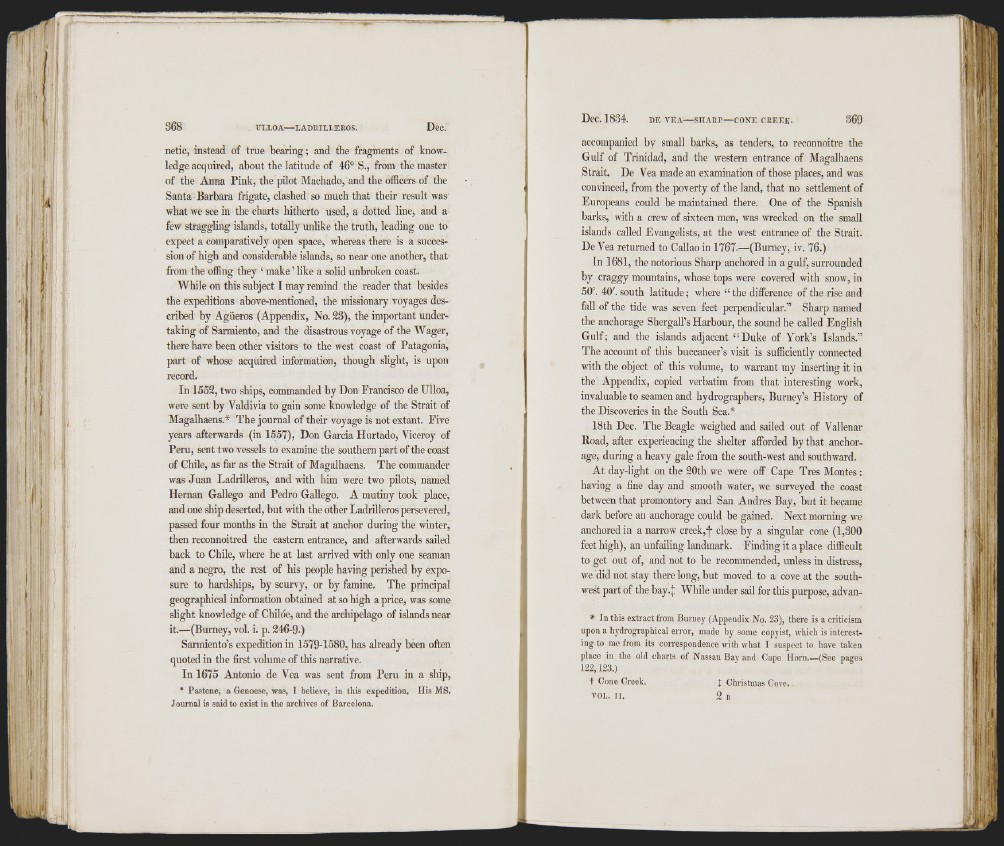
E
i f,
í
r '
368 ULLOA LADRILLEROS. Dec.
netic, instead of true bearing; and the fragments of knowledge
acquired, about the latitude of 46° S., from the master
of the Anna Pink, the pilot Machado, and the officers of the
Santa Barbara frigate, clashed so much that their result was
what we see in the charts hitherto used, a dotted line, and a
few straggling islands, totally unlike the truth, leading one to
expect a comparatively open space, whereas there is a succession
of high and considerable islands, so near one another, that
from the offing they ‘ make ’ like a solid unbroken coast.
While on this subject I may remind the reader that besides
the expeditions above-mentioned, the missionary voyages described
by Agüeros (Appendix, No. 23), the important undertaking
of Sarmiento, and the disastrous voyage of the Wager,
there have been other visitors to the west coast of Patagonia,
part of whose acquired information, though slight, is upon
record.
In 1652, two ships, commanded by Don Francisco de Ulloa,
were sent by Valdivia to gain some knowledge of the Strait of
Magalhaens.* The journal of their voyage is not extant. Five
years afterwards (in 1557), Don Garcia Hurtado, Viceroy of
Peru, sent two vessels to examine the southern part of the coast
of Chile, as far as the Strait of Magalhaens. The commander
was Juan Ladrilleros, and with him were two pilots, named
Hernán Gallego and Pedro Gallego. A mutiny took place,
and one ship deserted, but with the other Ladrilleros persevered,
passed four months in the Strait at anchor during the winter,
then reconnoitred the eastern entrance, and afterwards sailed
back to Chile, where he at last arrived with only one seaman
and a negro, the rest of his people having perished by exposure
to hardships, by scurvy, or by famine. The principal
geographical information obtained at so high a price, was some
sMght knowledge of Childe, and the archipelago of islands near
it.—(Burney, vol. i. p. 246-9-)
Sarmiento’s expedition in 1579-1580, has already been often
quoted in the first volume of this narrative.
In 1675 Antonio de Vea was sent from Peru in a ship,
• Pastene, a Genoese, was, I believe, in this expedition. His MS.
Journal is said to exist in the archives of Barcelona.
accompanied by small harks, as tenders, to reconnoitre the
Gulf of Trinidad, and the western entrance of Magalhaens
Strait. De Vea made an examination of those places, and was
convinced, from the poverty of the land, that no settlement of
Luropeans could be maintained there. One of the Spanish
barks, with a crew of sixteen men, was wrecked on the small
islands called Fvangelists, at the west entrance of the Strait.
De Vea returned to Callao in 1767.—(Burney, iv. 76.)
In 1681, the notorious Sharp anchored in a gulf, surrounded
by craggy mountains, whose tops were covered with snow, in
50°. 40'. south latitude; where “ the difference of the rise and
fall of the tide was seven feet perpendicular.” Sharp named
the anchorage Shergall’s Harbour, the sound he called Fnglish
Gulf; and the islands adjacent “ Duke of York’s Islands.”
The account of this buccaneer’s visit is sufficiently connected
with the object of this volume, to warrant ray inserting it in
the Appendix, copied verbatim from that interesting work,
invaluable to seamen and hydrographers, Burney’s History of
the Discoveries in the South Sea.*
18th Dec. The Beagle weighed and sailed out of Vallenar
Road, after experiencing the shelter afforded by that anchorage,
during a heavy gale from the south-west and southward.
At day-light on the 20th we were off Cape Tres Montes:
having a fine day and smooth water, we surveyed the coast
between that promontory and San Andres Bay, but it became
dark before an anchorage could be gained. Next morning we
anchored in a narrow creek,f close by a singular cone (1,300
feet high), an unfailing landmark. Finding it a place difficult
to get out of, and not to be recommended, unless in distress,
we did not stay there long, but moved to a cove at the southwest
part of the bay.] While under sail for this purpose, advan-
* In this extract from Burney (Appendix No. 23), there is a criticism
upon a hydrographical error, made by some copyist, whicli is interesting
to me from its correspondence with what I suspect to have taken
place in the old charts of Nassau Bay and Cape Horn (See pages
122,123.)
t Cone Creek. J Christmas Cove.
VOL. I I . 2 I!
f
%